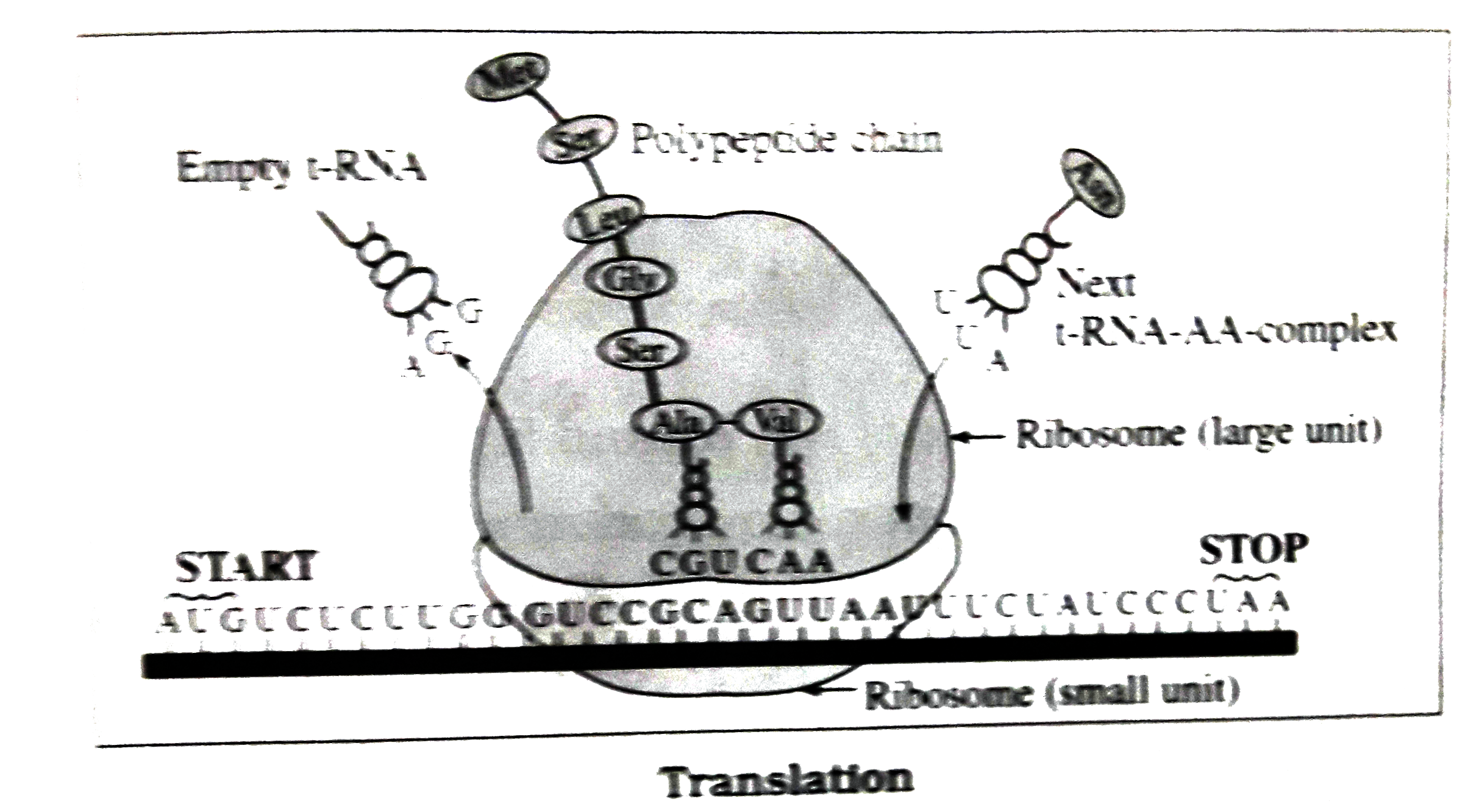Describe any two steps of formation of polypeptide chain.
Formation of the polypeptide chain :
This is the actual process of translation and it takes part in there steps. Viz. initiation ,elongation and termination.
(a) Initiation :
(1) During the process of initiation , there is formation of initiation complex. This requires the m-RNA having codons for the formation of polypeptide and two subunits of ribosomes, viz, 30S and 50S. Initial AA-t-RNA complex and ATP, GTP as source of energy.
(2) Initiation factors are also necessary for this process. In prokaryotes, the first AA-t-RNA complex has amino acid, N-formylmethionine (or f-met). n eukaryotes it is methionine (met).The process starts with binding of m-RNA in the smaller subunit of 30S on ribosome .
(3) AUG is the start codon, which is positioned properly.

(4) The AA-tRNA complex (f-met-RNA complex) then gets attached to the start codon at the P site of smaller subunit of ribosome.
This is done by anticodon, UAC of t-RNA. Then small and large subunits of ribosomes join and form 70S ribosome .
(5) The ribosome has three sites, viz. aminoacyl site (A) , peptidyl site (P) and exit site (E).After translation is over the empty t-RNA leaves from E site. The AA -t-RNA complex binds at P site directly. The other incoming t-RNA complexes get attached first at A site and then they are shifted to P site. Polypeptide chain which is being formed is released from P site.
(b) Elongation :
(1) The process of elongation starts after initiaion. This is done by the formation of peptide linkages between the successive amino acid molecules. This activity is catalyzed by an enzyme. Peptidyl transferase.
(2) Each t-RNA complex brings a specific amino acid. The anticodons and condons are complementary to each other. Due to this appropriate amino acids are placed in their proper position. For the elongation, elongation factors are needed.
(3) The ribosomes move along the m-RNA in step wise manner from start to stop codon in 5-3 direction. This movement is called transclocation. The movement of m-RNA is one condon ahead each time and therefore one amino acid is added in the polypeptide chain causing systematic elongation.
(c) Termination :
(1) Elongation continues till the last amino acid is added which has been coded by m-RNA. when m-RNA reaches either UAA, UAG or UGA which are termination codons then the termination process beings.
(2) The termination factors R1 , R2 and S play an important role in indetifying the stop or ermination codon and releasing the polypeptide chain.
(3) Once the termination is done, the smaller (30S) and larger (50S) subunits of ribosomes are freed from each other . The entire process of protein synthesis requires energy which is supplied by ATP and GTP.
Related Playlists
- BOOK - NAVNEET PUBLICATION - MAHARASHTRA BOARDCHAPTER - LONG ANSWER QUESTIONSEXERCISE - Photosynthesis15videos
LONG ANSWER QUESTIONS
- BOOK - NAVNEET PUBLICATION - MAHARASHTRA BOARDCHAPTER - LONG ANSWER QUESTIONSEXERCISE - Respiration4videos
LONG ANSWER QUESTIONS
- BOOK - NAVNEET PUBLICATION - MAHARASHTRA BOARDCHAPTER - LONG ANSWER QUESTIONSEXERCISE - Additional Important Questions for Self-practice1videos
LONG ANSWER QUESTIONS
- BOOK - NAVNEET PUBLICATION - MAHARASHTRA BOARDCHAPTER - GIVE REASONS EXERCISE - Organisms and Environment - II2videos
GIVE REASONS
- BOOK - NAVNEET PUBLICATION - MAHARASHTRA BOARDCHAPTER - MATCH THE COLUMNS/MATCH THE PAIRS/COMPLETE THE TABLEEXERCISE - Chapter 19 : Organisms and Environment - II3videos
MATCH THE COLUMNS/MATCH THE PAIRS/COMPLETE THE TABLE
Similar Questions
The main steps involved in the process of translation are
I.Activation of amino acid
II.Initiation of polypeptide chain synthesis
III.Termination of polypeptide chain formation
IV. Transfer of polypeptide chain to tRNAView SolutionExplain the steps involved in the elongation of polypeptide chain during protein synthesis.
View SolutionDescribe the steps involved in polypeptide chain elongation.
View SolutionDescribe the steps involved in the initiation of polypeptide synthesis.
View SolutionPolypeptides are the chains of
View SolutionThe structure of insulin consists of two polypeptide chains A and B . These two polypeptide chains
View SolutionAssertion : Hemoglobin is a monomeric protein .
Reason : It is made up of two polypeptide chains .View SolutionAssertion : Hemoglobin is a monomeric protein .
Reason : It is made up of two polypeptide chains .View SolutionWhich structure represents the overall folding of polypeptide chains ?
View SolutionThe hydrolytic step leading to the release of a polypeptide chain from a ribosome is catalysed by :
View Solution

